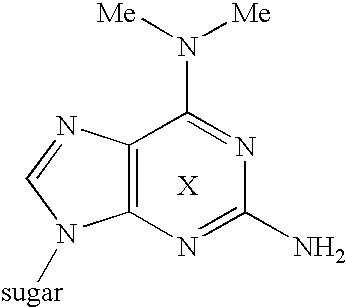Nucleic acid base pair
a nucleic acid base pair and nucleic acid technology, applied in the field of nucleic acid base pairs, can solve the problems of no practical use, low rate of incorporation of dytp by klenow fragments, recognition by polymerase,
- Summary
- Abstract
- Description
- Claims
- Application Information
AI Technical Summary
Benefits of technology
Problems solved by technology
Method used
Image
Examples
example 1
[0142]Synthesis of 2-benzamino-6-(N,N-dimethylamino)-9-[5′-O-dimethoxytrityl-3′-O-[[(diisopropylamino)-2-cyanoethoxy]phosphino]-2′-deoxy-β-D-ribofuranosyl]purine (10) (refer to FIG. 3)
(A) Synthesis of 2-amino-6-(N,N-dimethylamino)-9-(2′,3,5′-tri-O-acetyl-β-D-ribofuranosyl]purine (2):
[0143]2-amino-chloro-9-(2′,3′,5′-tri-O-acetyl-β-D-ribofuranosyl)purine (1) [M. J. Robins and B. Uznanski, Can. J. Chem., 59, 2601-2607 (1981)1(18.6 mmol, 7.96 g) was dehydrated three times azeotropically with anhydrous pyridine, and dissolved in anhydrous pyridine (180 ml), then dimethylamine hydrochloride (55.8 mmol, 4.55 g) and diisopropylethylamine (74.4 mmol, 12.9 ml) were added thereto with stirring at room temperature. The mixture was stirred at room temperature for 15 hours. After confirming completion of the reaction by TLC, water was added to the reaction mixture and concentrated in vacuo. Chloroform was added to the residue, and the organic layer was washed 3 times with water, 2 times with 5% a...
example 2
[0162]Synthesis of 2-isobutyrylamino-6-(2-thienyl)-9-[2-deoxy-3-O-[diisopropylamino]-(2-cyanoethoxy)]phosphino-5-O-dimethoxytrityl-β-D-ribofuranosyl]purine (22) (Synthetic Route is Shown in FIG. 5)
(A) Synthesis of 2-isobutyrylamino-6-iodo-9-(2-deoxy-3,5-di-O-isobutyryl-β-D- ribofuranosyl]purine (18)
[0163]2-isobutyrylamino-6-amino-9-(2-deoxy-3,5-di-O-isobutyryl-β-D-ribofuranosyl]purine (17) [Babara L. Gaffney, Luis A. Marky and Roger A. Jones, Tetrahedron, 40, 3-13 (1984)] 2.38 g (5 mmol) was heated at 60° C. under argon atmosphere. n-pentylnitrite 13.5 ml (0.10 mol) and diiodomethane 25 ml (0.31 mol) were rapidly added and suspended. The mixture was irradiated by visible light using 200 W halogen tungsten lump at the distance from light source 2 cm for 3 hours under well stirring at 60° C. To the reaction mixture, saturated aqueous sodium sulfite 30 ml was added and stirred at room temperature for 3 hours. Thereafter, saturated aqueous sodium sulfite 120 ml and chloroform 150 ml wer...
example 3
[0174]Synthesis of 3-(2′-deoxy-5′-O-triphosphoryl-βD-ribofuranosyl)pyridine-2-one (dYTP) (23) (Refer to FIG. 4)
(A) Synthesis of 3-(3′,5′-O-tetraisopropyldisiloxanyl-β-D-ribofuranosyl)pyridine-2-one (12)
[0175]3-(β-D-ribofuranosyl)pyridine-2-one (11) [J. Matulic-Adamic and L. Beigelman, Tetrahedron Lett., 38, 203-206 (1997)](2.29 mmol, 520 mg) was azeotropically dehydrated three times with anhydrous pyridine and was dissolved in anhydrous pyridine (23 ml). 1,3-dichloro-1,1,3,3-tetraisopropyldisiloxane (2.52 mmol, 0.81 ml) was added with stirring at room temperature and further stirred at room temperature for overnight. After confirming completion of the reaction by TLC, water was added to the reaction mixture to terminate the reaction and concentrated in vacuo. The residue was dissolved in chloroform. The organic layer was washed twice with aqueous 5% sodium hydrogen carbonate and once with aqueous saturated sodium chloride solution. The organic layer was dried with magnesium sulfate,...
PUM
| Property | Measurement | Unit |
|---|---|---|
| volume | aaaaa | aaaaa |
| volume | aaaaa | aaaaa |
| temperature | aaaaa | aaaaa |
Abstract
Description
Claims
Application Information
 Login to View More
Login to View More - R&D
- Intellectual Property
- Life Sciences
- Materials
- Tech Scout
- Unparalleled Data Quality
- Higher Quality Content
- 60% Fewer Hallucinations
Browse by: Latest US Patents, China's latest patents, Technical Efficacy Thesaurus, Application Domain, Technology Topic, Popular Technical Reports.
© 2025 PatSnap. All rights reserved.Legal|Privacy policy|Modern Slavery Act Transparency Statement|Sitemap|About US| Contact US: help@patsnap.com



